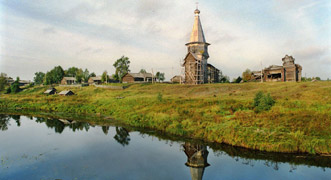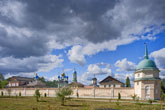The Trinity-Danilov Monastery: Apocalyptic visions in medieval Russia
Photographs by William Brumfield
Although less well known today than Vladimir, Suzdal or Novgorod, the town of Pereslavl-Zalessky was one of the most significant centers of medieval Russian culture. Indeed, its Trinity-Danilov Monastery contains one of most impressive examples of medieval Russian fresco art--all the more remarkable for depicting apocalyptic scenes of destruction and damnation.
Founded in 1152 by Prince Yury Dolgoruky ("the long-armed"), Pereslavl-Zalessky was strategically located on major routes from the interior of medieval Rus to the Volga River and the White Sea. Its center was marked by the ancient limestone Cathedral of the Transfiguration and a fortified area with a high earthen rampart – both of which still stand today.
The numerous monasteries of Pereslavl-Zalessky, located in the town and overlooking nearby Lake Pleshcheevo, were particularly important in the political and spiritual life of the Muscovite state. Among the oldest are the Monastery of St. Nicetas (Nikita), located on high ground to the north of Lake Pleshcheevo; and the Goritsky Monastery, overlooking the lake to the south.
The founder of the Trinity Monastery was a young monk named Daniil, born in Pereslavl-Zalessky in the late 15th century. Tonsured as a boy at the Borovsk-St. Pafnuty Monastery, Daniil returned to his hometown where he lived first at the Nicetas Monastery and then at Goritsky Monastery, where he became the hegumen, or abbot.
Known for his charity to the poor and homeless, Daniil received permission to establish a new monastery on lower ground near the fortress. 1508 is the accepted year of the founding of the monastery, originally dedicated to All Saints.
How to get there
To get to Pereslavl-Zalessky take a bus from the Moscow autostation (Schyolkovksya metro station; departure from 7:00 a.m. every 30 min.). The trip takes approximately 2,5 hours.
In recognition of his spiritual authority, Daniil was appointed advisor and confessor to the ruler of Muscovy, Grand Prince Basil III (1479-1533). By 1525 ,Basil faced a possible dynastic crisis due to the lack of a male heir. With the support of the church Basil annulled his marriage to Solomoniia Saburova, who entered Suzdal's Intercession Convent.
Basil's second marriage, to Elena Glinskaya, did not initially produce the desired issue. In supplication for the birth of a son, the royal couple undertook pilgrimages to monasteries. The Trinity Monastery, under the spiritual guidance of Daniil, was particularly revered by Basil. With the birth in August 1530 of his son Ivan IV (subsequently known as Ivan the Terrible), Basil gratefully supported the construction of the monastery's main church, the Cathedral of the Trinity.
Built of brick between 1530 and 1532, the Trinity Cathedral is an excellent example of early 16th-century church design, with a square plan and a symmetrical division into three bays. Despite the modification of its roofline, which originally followed the curves of the semicircular gables (zakomary), the basic structure of the Trinity Cathedral remains intact. The cathedral is crowned by a single cupola on a high cylinder, or drum. As the monastery's primary masonry structure during the 16th century, the white-walled cathedral served as a landmark among the surrounding dark log structures.
Despite its status at the Muscovite court, the monastery shared in the chaos that afflicted central Russia during the latter part of Ivan the Terrible's reign. The situation worsened after the death of Tsar Boris Godunov in 1605. Without a clear successor to the throne, Russia was wracked by competing armies and massive social disorder during what came to be known as the Time of Troubles.
Pereslavl-Zalessky supported successive competing factions, none of them successful. Much of the population was killed or died of disease and hunger. In 1608 the town was occupied by Polish-Lithuanian forces who sacked the monasteries – Holy Trinity among them.
As it gradually recovered after this devastation, Pereslavl-Zalessky and its monasteries benefited from the location on a major route to the north. During the long reign of Tsar Alexei Mikhailovich (r. 1645-76), the Trinity Monastery returned to court favor.
Equally important was the support of the energetic prelate Jonah Sysoevich (ca. 1607-90). As metropolitan of the wealthy diocese based in the neighboring town of Rostov, Jonah took an active interest in establishing the cult of Daniil at the Trinity Monastery. In 1653 he supervised the discovery of Daniil's relics on the monastery grounds. This proved to be the first step toward a rapid canonization in 1653-54 with the approval of Patriarch Nikon in Moscow. In 1660, Jonah built a chapel dedicated to Daniil a t the north wall of the Trinity Cathedral.
The canonization of Daniil led to a vibrant period in the monastery's history. Large donations from wealthy patrons as well as the Muscovite court enabled the monastery manager to embark on the long-delayed painting of the interior cathedral walls. Fortuitously, the project occurred at a time of extraordinary creativity among groups of painters in Yaroslavl and Kostroma. These painters were active not only in their own flourishing towns, but also in Rostov and Moscow under the patronage of Jonah.
With his high regard for the Trinity Monastery, Jonah agreed to send one of the most accomplished groups of Kostroma painters, including the masters Gurii Nikitin and Sila Savin. Although occupied with complex projects in Moscow (notably, the repainting of the frescoes at the Archangel Michael Cathedral in the Kremlin), the Kostroma painters arrived at Trinity Monastery in 1662. Remarkably, the painters completed the major subjects by the fall of that year. But due to the demand for their work, they were pulled from the cathedral and did not return until 1682, despite many entreaties from the abbot.
To this day, the frescoes retain their power. In part this can be explained by the deep piety of their traditional, archaic style of expression. Yet the unusual content – the Apocalypse – is equally compelling.
Why the Apocalypse? Russian churches often depict the Last Judgment on the west wall, yet a detail representation of the Apocalypse (from the vision of St. John on Patmos) is rare. Perhaps memories of the Time of Troubles played a role in the choice of subject. But the Russian Orthodox Church had also entered a time of great turbulence in the 1650s, when Patriarch Nikon promulgated liturgical reforms that shocked traditional believers. Although Nikon was deposed, the state insisted that his reforms be implemented. The result was a profound schism in the Church and the rise of dissenting groups generally known as Old Believers. Impassioned disputes and persecution swept the church.
Whatever the connection with external events, the Kostroma painters conveyed cataclysmic images taken both from the Book of Genesis and the Book of Revelation, the alpha and omega. On the west wall, for example, Lot and his family are depicted fleeing danger before the destruction of Sodom and Gemorrah. The south wall is especially vivid in its portrayals of phantasmagoric beasts with direct references to passages from the Revelation.
In the dome, high above it all, is a majestic image of Christ Ruler of All (Pantokrator). Considered one of the great accomplishments of medieval Russian art, this fresco is a sublime culmination to the agitated display on the cathedral walls.
The Trinity Monastery continued to flourish during the latter part of the 17th century. Its cathedral was enhanced by the construction of a large "tent" bell tower in 1689. Other structures of that period include the Church of All Saints, built in the 1680s in a modest, appealing design. Of special note is the Church of the Praise of the Virgin (1695) with an unusually large refectory (dining commons) attached. Most of this construction was supported by Prince Ivan Baryatinsky, who retired to the monastery and took the name Efrem. He also built the west gate church, dedicated to the Tikhvin Icon of the Virgin (1700).
The Trinity-Danilov Monastery was closed in 1923, at the beginning of Soviet rule, and severely vandalized. The cathedral icons were lost or destroyed. A limited attempt to clean the frescoes in 1982 faltered for lack of funding. In 1995 the monastery was finally returned to the church, and the painstaking work of restoration continued. Surviving through decades of neglect, the magnificent frescoes in the Trinity Cathedral have now been revived in all their astonishing brilliance.
All rights reserved by Rossiyskaya Gazeta.
Subscribe
to our newsletter!
Get the week's best stories straight to your inbox


